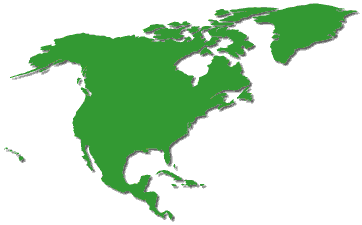From north to south it measures 7400km and from east to west 5700km. The east coast faces the Atlantic Ocean and the west coast faces the Pacific. In northeast of Northern America, there is much water within the continent's most temperate zone, including the Great Lakes of Superior, Michigan, Huron, Ontario and Erie. Within Canada, in the north, the Rockies chain of mountains stretch south into the USA. In the Deep South of the USA, the mighty Mississippi River makes its way from the central lowlands and into the Gulf of Mexico. In the southwest of the continent, there are many desert regions including the Arizona and Sonoran deserts. Other, more famous natural features include Niagara Falls on the USA and Canada border in the northeast and the Grand Canyon in the west of the USA. Much of the west coast of America lies along the San Andreas fault, making many cities prone to earthquakes. The highest area of elevation is Mount McKinley in Alaska, which reaches a height of 6194m. The lowest point is the Death Valley in California at -86m. The lowest recorded temperature was -66C (in Greenland) and the highest was 57C in California.Most of Central America receives a tropical climate, and this compliments the verdant landscape which houses large central areas of plateau and low-lying rainforests that support a wide range of tropical flora and fauna. Earthquakes and over forty active volcanoes are attributes that can really test the terrain of Central America. Large natural features include the Sierra Madre mountain range, Lake Nicaragua and the American-built Panama canal, which allows ships to sail from Pacific South America, into the Caribbean. The Caribbean falls within Northern American and is represented by the West Indies islands. This chain of tropical islands trails in a downward arc from the Gulf of Mexico to Venezuela. The islands have a general terrain of low-lying, rugged interiors and coastlines offering white sandy beaches, shaded by coconut palms facing azure seas. Please use the links below for further Information |
